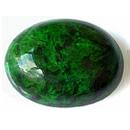|
|
|
|
Click on a letter above to view the list of gems. |
|
|
|
|
|
Maw-sit-sit
(Kosmochlor
- Jade) |
|
| Chemistry: NaCr[Si2O6] + Fe, Mg | |
| Discovered
in the early 1960's;
IMA
status: Not Valid | ||
|
| ||
|
Classification |
|
|
| |
|
Silicates | |
|
8/F.01-10 (Kosmochlor) | |
|
|
8 : Silicates |
|
|
|
|
Crystal Data |
|
|
|
|
|
Monoclinic - Prismatic (Kosmochlor) |
|
|
Massive |
|
|
None |
|
|
|
|
|
Physical Properties |
|
|
|
|
|
[110] Good (Kosmochlor) |
|
|
Irregular to Conchoidal |
|
|
Brittle |
|
|
Varies, up to 7.0 |
|
|
2.50 - 3.20 (g/cm3) |
|
|
None |
|
|
Not Radioactive |
|
|
|
|
|
Optical Properties |
|
|
|
|
|
Vivid Emerald Green to Dark Green, with black splotches, swirls and veins |
|
|
Opaque |
|
|
Vitreous to Greasy |
|
|
1.52 - 1.74; most commonly around 1.52 |
|
|
Varies |
|
|
Moderate to Strong; r > v (Kosmochlor) |
|
|
Strong; X = yellowish green; Y = blue-green, grass-green; Z = emerald-green (Kosmochlor) |
|
|
|
|
|
Occurances |
|
|
|
|
|
Geological Setting: |
Maw-sit-sit was the result of high pressure, low temperature metamorphism of a chromium-rich ultramafic rock. |
|
Type Locality: |
Tawmaw, Myitkyina-Mogaung District, Kachin State, Myanmar |
|
Year Discovered: |
Early 1960's |
|
View mineral photos: | |
|
|
|
|
More Information |
|
|
|
|
|
|
Mindat.org
(Kosmochlor) |
|
|
|
|
The
only source of Maw-sit-sit is still the place where
it was discovered, Tawmaw, Myitkyina-Mogaung District, Kachin State, Myanmar
(Burma). |
|
|
We
have not photographed our Maw-sit-sit gems yet. Please
check back soon! |
